Sunday, September 24, 2006 - Eisriesenwelt Höhle and
Großglockner Hochalpenstraße, Austria
The typical breakfast fare of cold cuts, cheese, hard rolls,
and boiled eggs this morning. Okay, fine, but I'm getting a little
tired of it. I tried to eat quite a bit, though, because we had an
active day planned. The juice glasses today were 1/8-liter glasses,
which we found strange. First, it's especially tiny. Second, what's
the point of metric if you measure in eighths?
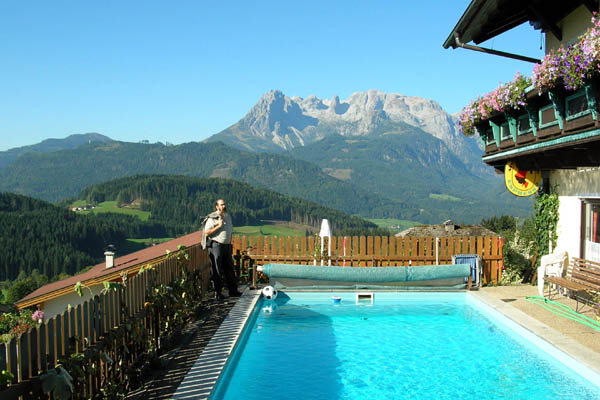
From the Gasthaus Sonneck
Burg Hohenwerfen is the dramatic-looking castle we saw
yesterday on the way into town. Dating from 1077, it sits
formidably atop a hill in the middle of a valley, with the Alps
towering overhead in all directions. They do a falconry show I'd
love to see, but no time again - Too much to do today. There are a
lot of places left to visit the next time we come to Oktoberfest!
I'd also like to tour one of the nearby salt mines.
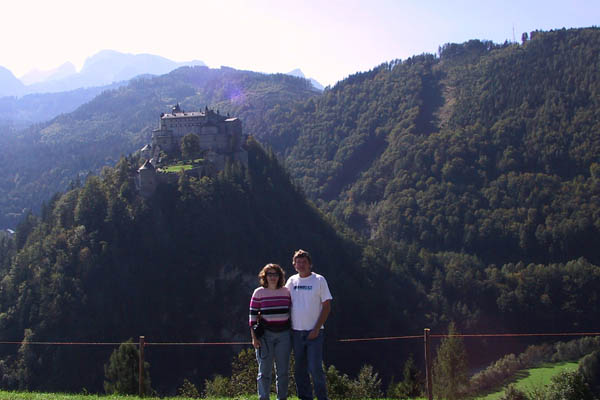
Burg Hohenwerfen
Eisriesenwelt Höhle is the largest and most fantastic system
of ice caverns in the world, with 42 kilometers of known passages.
The cave is located just outside the village of Werfen. Our visit
took about four hours round trip from the car park located
partially up the mountain. From the car park (1000 meters), it's a
20-minute hike to a cable car (1075 meters). From the top of the
cable car (1575 meters), it is an additional 20-minute hike to the
entrance of the cave, at 1641 meters. The 75-minute cave tour
itself includes 1400 stairs. It's a moderately strenuous adventure,
but it's worth it. The best caves are always hard to get
to.
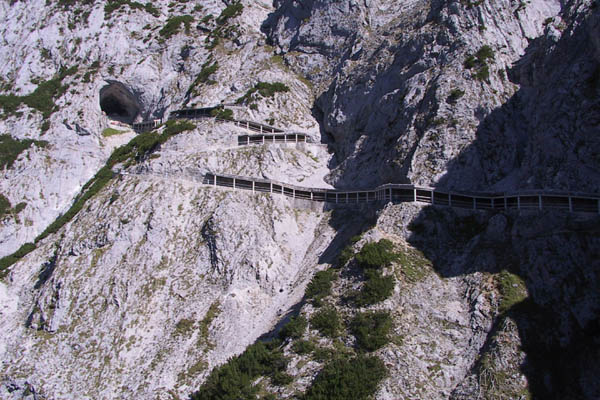
Path to Eisriesenwelt Höhle
Round trip on the cable car plus a tour of the cave costs
€17. If you want to save €9, you can skip the lift and hike up
instead. Not me, buddy. The scenic vistas on the portion of the
hike we did do, however, were fantastic, with great views of Burg
Hohenwerfen and the Alps.
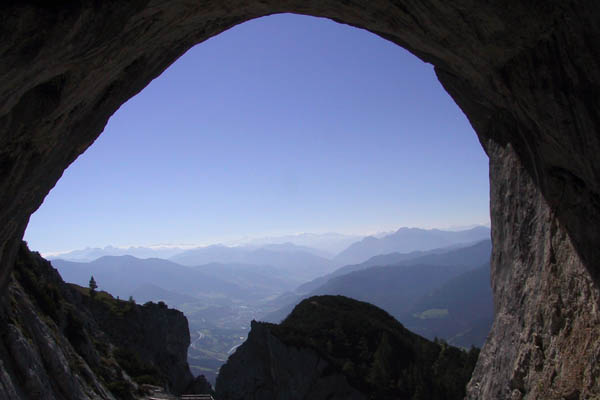
Looking out the ice cave
A guide met us at the cave entrance and divided the group
into English and German speakers for a bilingual tour. There is no
electric light in the cave, so our guide handed out open-flame gas
lamps to every tenth person or so. Brian, looking all responsible,
I assume, got to hold one of the lamps. A door has been built over
the main entrance to the cave, and when the door is opened, an icy
wind blows out, extinguishing everyone's lamps! Our guide quickly
re-lit the lamps, and we were on our way.
Eisriesenwelt Cave is a typical limestone cave, made
spectacular by the ice. The ice is formed from thawing snow which
drains into the cave and freezes. The cave is located at an
elevation where the average temperature is below freezing, so the
water stays frozen. The cave has ice stalagmites and stalactites,
frozen waterfalls, and all sorts of weird, wonderful ice
formations. I was all bundled up for the cold, but I hadn't packed
any gloves, and the handrails were chilling! We walked one
kilometer into the mountain, over 1400 stairs, to a high point of
1775 meters. The biggest room on the tour is 70 meters by 40
meters. The most stunning formations are illuminated by the guide
burning a magnesium ribbon.
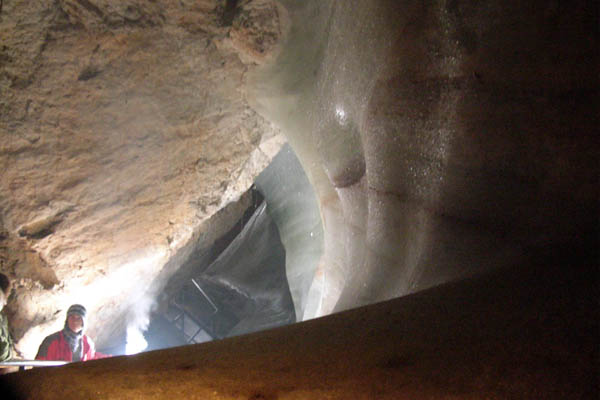
Inside the Eishöhle
It was after 3:00 p.m. by the time we got to Hohe Tauern
National Park. Hohe Tauern is Europe's largest national park (1787
square kilometers), through which winds the Grossglockner
Hochalpenstrasse, regarded as the most spectacular highway through
the Alps. A one-day pass on the road is €26 per car, kinda pricy,
but worth it. The road was built in the 1930s as a public works
project to create jobs during the depression. It took 3200 men five
years to build. Twenty percent of traffic on the road is bikers,
who love its 28 hairpin turns.
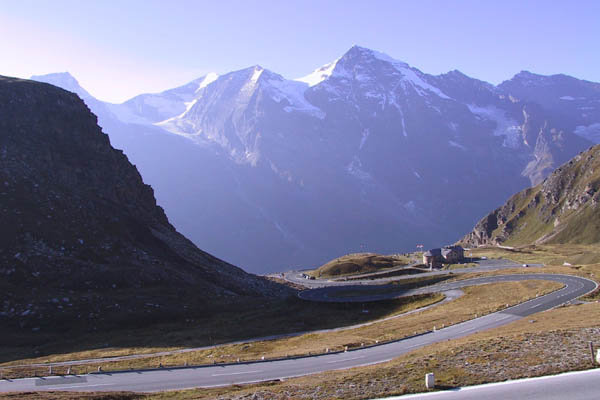
Grossglockner Hochalpenstrasse
Grossglockner High Alpine Road runs approximately 50
kilometers, between Bruck in the north, where we began, and
Heiligenblut in the south, and ranges in elevation between 800
meters and 2504 meters. There are plenty of places along the road
to pull over and admire the mountains. A steep two-kilometer side
road goes to Biker's Nest Viewpoint on the Edelweiss-Spitze, higher
yet at 2571 meters, with panoramic views of over thirty 3000-meter
peaks.
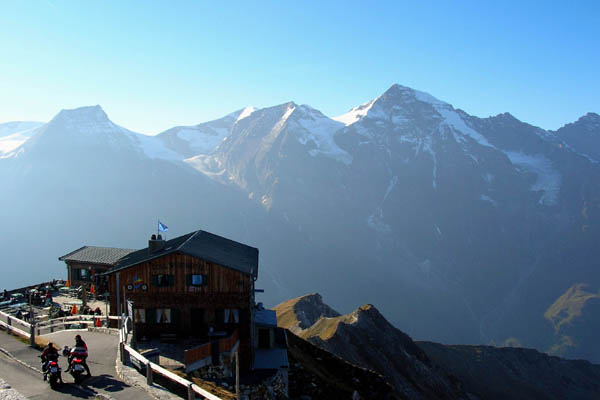
View from the Edelweiss-Spitze
Just south of the Hochtor, or high pass (2504 meters), of
Grossglockner Road is a nine-kilometer side road, the
Gletscherstrasse (Glacier Road), leading to the
Kaiser-Franz-Josefs-Höhe, where you can view the 10-kilometer long
Pasterze Glacier, the longest glacier in the eastern Alps, and the
Grossglockner, at 3798 meters, Austria's highest peak. There are a
lot of cool waterfalls along the Gletscherstrasse.
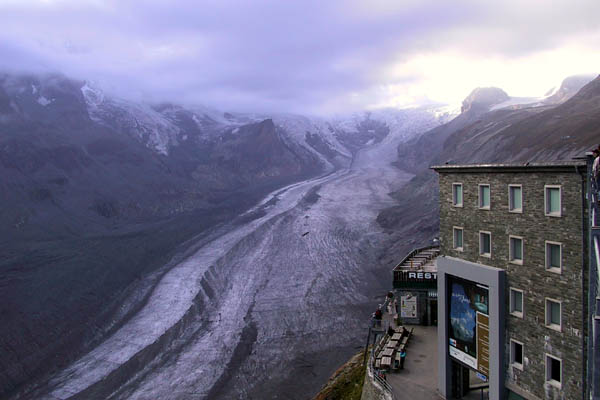
Pasterze Glacier
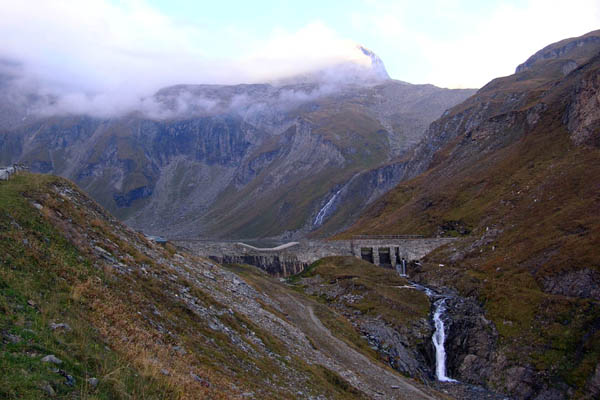
Along the Gletscherstrasse
Back on the main road, we descended into Heiligenblut, a
picturesque little village in a gorgeous, steep, green valley. We
stopped here at the last waterfall of the day, the Jungfernsprung,
a striking falls of 130 meters.
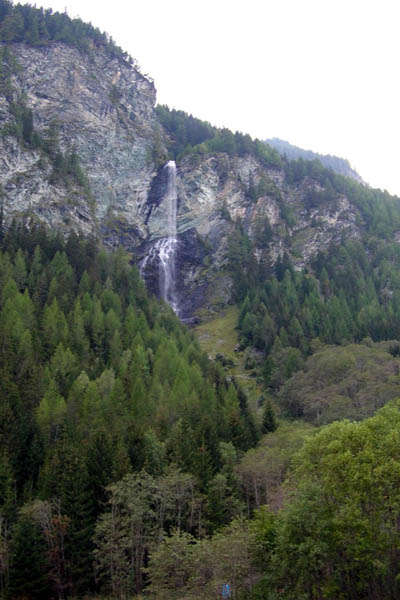
Jungfernsprung waterfall
A few more curvy roads brought us to our hotel in Lienz at
about 7:15 p.m., Gasthof Goldener Stern (€93 for a triple with
breakfast). The proprietress showed us to our room, took our
passports, and never came back. I assume we'll be getting those
back in the morning. Our balcony overlooks a lovely
courtyard.
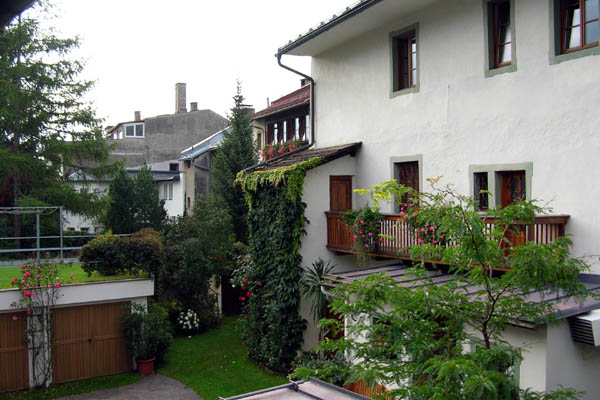
Courtyard of the Gasthof Goldener Stern, Lienz, Austria
Being Sunday, there wasn't a lot of choice when we went out
for dinner after 9:00 p.m. I was hoping for Italian food since we
were only 40 kilometers from Italy, but no such luck. We walked
around awhile and ended up at a Chinese place, Zhong Hua, where we
had great fun attempting to decipher the Chinese menu, helpfully
translated into German! The menu did have pictures of pigs, cows,
etcetera, so at least we knew we were ordering, for example,
chicken with something and something. The food was pretty average
and the service almost nonexistent. We had a nice walk along the
fast-flowing Isel River on the way back to the hotel.
|










